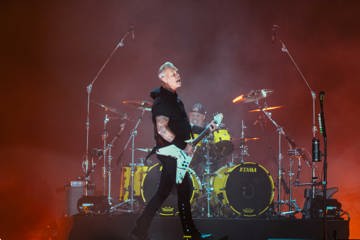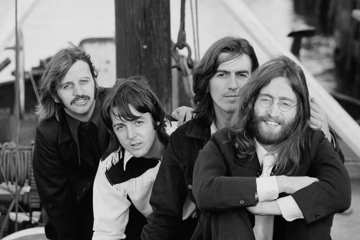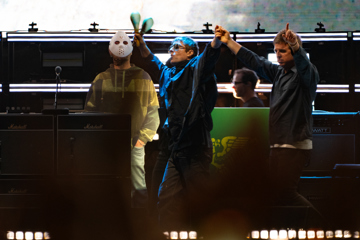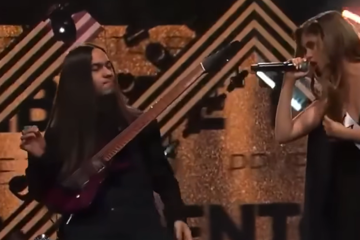The Triumphs And Troubles Of Talking Heads' Cinematic Live LP
Thirty years on from its release, we look back at the many faces of 'Stop Making Sense'
Band: Talking Heads
Album: Stop Making Sense
Label: Sire/Warner
Release Date: 15 October 1984

As a rule, both live records and movie soundtracks are somewhat dubious concerns as far as albums in general go. They are oft-considered to be strange and nefarious beasts, misunderstood and approached warily with an inherent scepticism, simply because so many of their genre forebears have proved insipid or uninspiring. With that in mind, spare a thought for Talking Heads’ seventh album Stop Making Sense — a live concert recording which also served as a soundtrack for the film of the same name. Yet somehow, against all odds, the album became a runaway success, spending over two years in the Billboard 200 chart and ultimately going double-platinum in the USA (and gold in the UK).
At the time of its 1984 release, Talking Heads were already very much a well-known concern, having coalesced in New York City in 1975 around the four members who would remain the band’s core until their relatively acrimonious dissolution in 1991; David Byrne (vocals/guitar), Chris Frantz (drums/vocals), Tina Weymouth (bass/vocals) and Modern Lovers alumnus Jerry Harrison (keyboards/guitar/vocals). From the outset, the band was a unique proposition, possessing a very arty, theatrical bent which perfectly abetted their strange take on new wave rock’n’roll; their sound owed as much to the avant-garde world as the pop sphere and showcased plenty of funk and world-music influences, yet at its core remained inherently accessible and infectious.
Don't miss a beat with our FREE daily newsletter
The inscrutable Byrne was the band’s focus, definitely more geek than chic but still possessing an idiosyncratic appeal to the everyman. Their music tended to change quite dramatically between releases, but nonetheless by 1984 they’d built a strong following on the back of a stream of singles including Psycho Killer, Al Green cover Take Me To The River, Life During Wartime, Once In A Lifetime and Burning Down The House.

That last track was the smash single from their 1983 studio album Speaking In Tongues, which of course in true rock’n’roll tradition prompted an extended tour to promote the album. To do so they designed an elaborate stage production — as much theatrical event as rock concert — and took that on the road around America. Largely Byrne’s brainchild by all accounts, the concert was designed as a gradual build; the frontman would enter a literally empty stage carrying just a guitar and a boombox, press play (to give the impression that he was actually playing the recorded beats on tape rather than them coming through the desk) and kick off with an impassioned solo rendition of the band’s first hit, Psycho Killer. Then Weymouth joins the fray and the pair offer Heaven as a duo, before Frantz’s drumkit is wheeled out for Thank You for Sending Me An Angel and so on and so forth.
By the end of the set, the full band have further been joined by percussionist Steve Scales, fabulous backup singers Edna Holt and Lynn Mabry, keyboardist Bernie Worrell (of Parliament/Funkadelic fame) and guitarist Alex Weir. It must be said that this extended version of the band is a fearsome live proposition and provide an incredibly fun visual feast to boot (Byrne having been largely freed from his guitar duties to perform his strange and wonderful choreographed run/dance routines). Frantz told Music Mix in 2009 that, “It was a very transcendent experience, every night, that tour”. Tellingly, the way the show gradually builds from the minimalist opening stanza to the funk-tastic party vibe of the finale is a wonderful conceit, a huge part of the tour’s appeal. Byrne himself states in the DVD commentary, “My character starts off as Mr. Stiff White Guy and does his very, very best to get down and loose by the end of the show, to kind of shed his inhibitions”.
And it was this last aspect which prompted filmmaker Jonathan Demme to approach the band about making the concert film which would eventually become the acclaimed Stop Making Sense. Reportedly attracted to the narrative structure of the production, Demme — who at that stage had six feature films under his belt but was some years away from becoming the household name he ended up due to smashes like Silence Of The Lambs (1991) and Philadelphia (1993) — approached them about recording the production for film, and there seems to have been little hesitation on the band’s part to get involved (they raised the film’s $1.2 million budget themselves). Accordingly, three consecutive nights were filmed in December, 1983 at LA’s Pantages Theatre — a 2,500-capacity venue, so still relatively intimate — and the film eventually premiered to packed houses in April, 1984.
It’s an odd entity by traditional concert film standards; no interviews or backstage footage at all make it unique for a start, but they also were unafraid to break from the norm in regards to lighting, the use of lengthy single takes and an almost complete lack of close-ups. Furthermore, where most live concert films and albums over-exaggerate the crowd response — to the point it sometimes feels like it’s been dubbed on entirely — on Stop Making Sense the fanfare is far less audible than usual, Byrne quoting in the DVD extras that this was, “intended to enable the viewer to form their own opinion about the performance”. The movie was an immediate hit both critically and commercially — respected Rolling Stone pundit Peter Travers named it the second-greatest concert film of all time, stating, “This is America’s peerless rainbow-funk-art-and-party band, and Demme makes it seem like they’re playing just for you”. Slate recently called the movie, “one of the most influential and beloved concert films ever made”. Its box office (prior to taking video and DVD sales into account) was just shy of $5 million, making it an instant winner financially to boot.
Accordingly, given all of this positivity, a soundtrack album was always on the cards. Strangely, Talking Heads had released a live album already, 1982’s The Name Of This Band Is Talking Heads, but there was fortunately minimal overlap between that lengthy document and the set-list from the Stop Making Sense shows. The problem which quickly arose, however, was that there was no way that the entire performance of 16 songs shown in the film was going to fit onto two sides of vinyl (the dominant format of the day), so the decision was made to not only cut down the soundtrack album to just nine songs but to also run them in a different order and heavily edit them to fit each side of the platter (longer edits, still different to the movie in places, were retained for the cassette and later CD releases). Strangely, the soundtrack also contained different mixes to the movie, Franz saying years later upon the film’s re-release, “The feeling at the time was that if we wanted to get it played on the radio — which we did — the album had to meet the production values of the time that radio was insisting upon. Therefore, there was a lot more time spent on the album mix than there was on the film soundtrack.”
To say that fans who had loved the movie — many seeing it numerous times in the cinemas — were nonplussed by all of this is a massive understatement. Web bible Allmusic gave the album 3½ stars, but it’s their critic Michael Hastings’ comments which stand out: “Since its release, purists have found Stop Making Sense slickly mixed and, worse yet, incomprehensive. The nine tracks included jumble and truncate the natural progression of frontman David Byrne’s meticulously arranged stage show”. He then posited that it should have been a double album (conceding that “it is, by any account, an exemplary snapshot of a band at the height of its powers”), before turning on the band-led production; “If anything, Stop Making Sense’s emphasis on keyboards and rhythm is its greatest asset as well as its biggest failing; knob-tweakers Chris Frantz and Jerry Harrison play up their parts at the expense of the treblier aspects of the performance.”
Yet all of this criticism is predicated on the notion that the listener is au fait with the film, which wasn’t always the case (a much younger version of this writer, for instance, got into Talking Heads upon the release of 1985’s massive Little Creatures album and subsequently bought Stop Making Sense on cassette after the fact, unaware of the background brouhaha). The film’s success clearly owed a lot to the theatrical and visual elements that Demme captured so well, but the soundtrack album proves that the music works perfectly well in isolation. It still opens with Psycho Killer but then reels off four straight tracks from Speaking In Tongues — Swamp, Slippery People, Burning Down The House and Girlfriend Is Better (during which Byrne dons the enormous oversize suit which he frequently later claimed will haunt him to his grave). The second side is a similar grab bag of earlier material, featuring Once In A Lifetime, What A Day That Was (from Byrne’s solo soundtrack to The Catherine Wheel), Life During Wartime and the raucous take on Take Me To The River to close. It remains weird and arty, but always dancey and accessible, a winning combination.

The reviews for the soundtrack were pretty great across the board. It came in at #345 on Rolling Stone’s 500 Greatest Albums Of All Time list, described as “Eighties art funk at its finest” (only a handful of live albums feature higher on the list, plus two soundtracks; The Who’s Quadrophenia (#122) and Jimmy Cliff’s reggae gangster masterpiece The Harder They Come (#267)). In their contemporaneous review, Rolling Stone gave it 4 stars, Christopher Connelly claiming, “Unlike the film of the same name, the album doesn’t follow the chronology of the concert, during which instruments were added one by one until the entire band was plugging away. Instead, what follows after a boom-b0x-and-acoustic-guitar rendition of Psycho Killer is an assortment of more recent up-tempo hits, delivered with the conviction and sheer joy that have enhanced the Heads’ remarkable body of work.”
Sputnik Music concurred, giving it 4½ stars and claiming, “Talking Heads’ abstract musical persona is realised in a pure and unhindered form on Stop Making Sense, making the live album one of the best in its class and beyond.” It came in at #61 on Slant Magazine’s 100 best Albums Of The 1980s feature, an unnamed scribe claiming that the soundtrack is, “subject to endless hemming and hawing amongst Talking Heads’ diehards for the elisions made to said concert’s set list when the soundtrack was being produced… Stop Making Sense, even in its truncated form, is a testament to one of the most compelling, forward-thinking bands of the rock era at the peak of their craft”.
In later years, there were efforts made to rectify some of the misgivings stemming from the original soundtrack release. In 1999, Stop Making Sense was reissued in a special expanded CD format in an attempt to placate those ruing the original version’s divergence from the film — staggeringly, this update (despite reinstating all of the missing tracks from the movie and returning them to chronological order) contains versions of some songs that are longer than the original CD versions but still edited in length from the versions that appear in the movie. Also there are a couple of bonus tracks floating around on VHS and DVD releases of the film (Cities and Big Business/I Zimbra) that were part of the original concerts but didn’t make the cut for the movie, meaning that for all intents and purposes there are now five different versions of Stop Making Sense doing the rounds:
- Original vinyl version (9 tracks)
- Original cassette/CD version (9 tracks, longer edits)
- Original film version (16 tracks)
- 1995 reissue CD (16 tracks, shorter edits)
- VHS/DVD and 2014 digital version (18 tracks).

It’s confusing as fuck but best not to think about it — if this music is your cup of tea then they’re all pretty good, and will all still get your feet tapping and induce that trademark Talking Heads goofy grin. More of an elaborate production than a ‘greatest hits’ set, the Stop Making Sense tour found the great band at the top of their game and seemingly having a ton of fun in the process, and as a result it’s completely infectious. The soundtrack confused a lot of fans (especially at the time) and even the band has reservations — in 2011, Byrne told Pitchfork (largely in context of the show’s theatrical production standards) that, “I’m proud of Stop Making Sense, but it’s a little bit of an albatross; I can’t compete with it but I can’t ignore it either”. No matter your take on the band one thing is certain — Stop Making Sense will go down as one of the most successful live concert film soundtracks in the history of music (if only because people don’t buy albums en masse anymore).
And really, at the end of the day, an album should be judged on what it is rather than what it isn’t, as difficult as that may occasionally prove. It’s all in the title, really…
STOP MAKING SENSE TRACKLIST (1984)
- Psycho Killer
- Swamp
- Slippery People
- Burning Down The House
- Girlfriend Is Better
- Once In A Lifetime
- What A Day That Was
- Life During Wartime
- Take Me To The River
STOP MAKING SENSE TRACKLIST (1999)
- Psycho Killer
- Heaven
- Thank You for Sending Me An Angel
- Found A Job
- Slippery People
- Burning Down The House
- Life During Wartime
- Making Flippy Floppy
- Swamp
- What A Day That Was
- This Must Be The Place (Naive Melody)
- Once In A Lifetime
- Genius Of Love (performed by Tom Tom Club)
- Girlfriend Is Better
- Take Me To The River
- Crosseyed And Painless
FURTHER VIEWING
Watch David Byrne discuss Stop Making Sense (the film) at the Film Society of Lincoln Center (August, 2014);
And watch this quasi-bizarre footage of Byrne interviewing himself (special feature on Stop Making Sense DVD);







